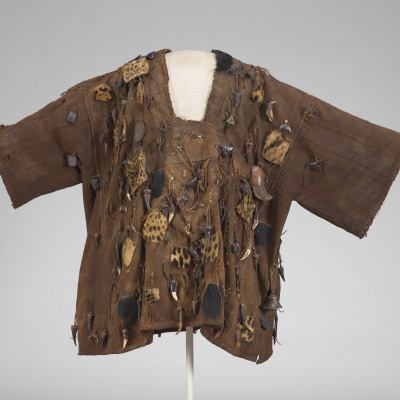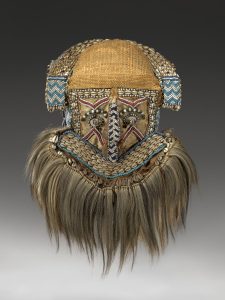
I Am: Identity in African Art
What can the visual arts tell us about an individual or a community? This resource explores the concept of identity in traditional African art and culture by focusing on twelve objects that speak to various roles within a society. These objects represent cultural groups from different parts of the continent, reminding us of the diversity that exists across Africa.
Introduction
What can the visual arts tell us about an individual or a community? This resource explores the concept of identity in traditional African art and culture by focusing on twelve objects that speak to various roles within a society. These objects represent cultural groups from
different parts of the continent, reminding us of the diversity that exists across Africa.
The artists who created these works developed a visual language to convey aspects of individual and cultural identity such as age, status or profession, and spiritual beliefs.The majority of pieces were produced in the late 19th or early 20th century and are considered traditional African art. However, identity is continually being refashioned to meet new needs, and as these roles change we see old forms evolve into new ones.
Whether expressing individual or community characteristics, the images seen reveal the union between art and life in Africa. They range in material and function and display important concepts that anyone, anywhere, can appreciate and understand.
I am... a Hunter
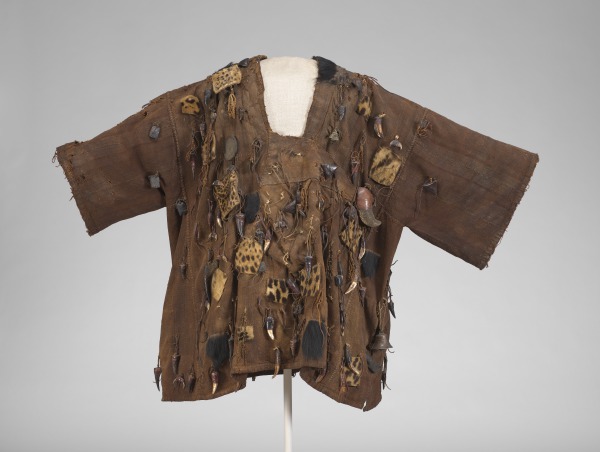
Hunter’s Shirt, 19th–20th century, Bamana culture (Mali), Strip cloth, various attached talismans, 33 ½ in. high, Gift of Robert and Nancy Nooter, 95.66
The Bamana (bah-mah’-nah) people are farmers and hunters living on the western edge of the Sahara Desert. Traditionally, hunters prepared to go into the realm of dangerous animals and spirits by participating in rituals that took place at the boundary between village and wilderness. Tunics such as this Hunter’s Shirt helped them call on supernatural energies for safety and success.
This Hunter’s Shirt is made of mud cloth, which consists of white cotton strips that were sewn together and then dyed with mud. The cloth is decorated with an array of animal fragments and charms, including special pouches called basi. The Bamana people believe that if the basi are opened, the charms inside lose their power to ward off evil and bring good fortune to the wearer.
Decorated tunics are worn as symbols of success during festivals, processions, and other gatherings. The hunter’s ability to straddle the boundary between known and unknown ensures his important status in the community.
I am...an Elder
The Ogboni society, made up of elders, is one of the most important Yoruba [yoroo-BUH] governing institutions. By virtue of their age, Ogboni are considered close to the spirit-realm of the ancestors. Within each community, they decide the most serious judicial matters and control the selection, installation, and funerals of community rulers.
The facial features on this plaque illustrate several Ogboni concepts. The bulging forehead suggests intellectual power, and the projecting eyes signify penetrating insight as well as ase, “spiritual energy or life force.” Two mudfish issue from the nostrils; these fish, who can live in water or on land, serve as a metaphor for the Ogboni ability to cross between the two halves of the Yoruba universe—aye, the world of the living, and orun, the spirit-realm.
The small holes along the edge of this plaque provide loops for attaching it to ceremonial garb. When not being worn, this plaque might have been placed on an altar, where sacrificial offerings would be poured over it.
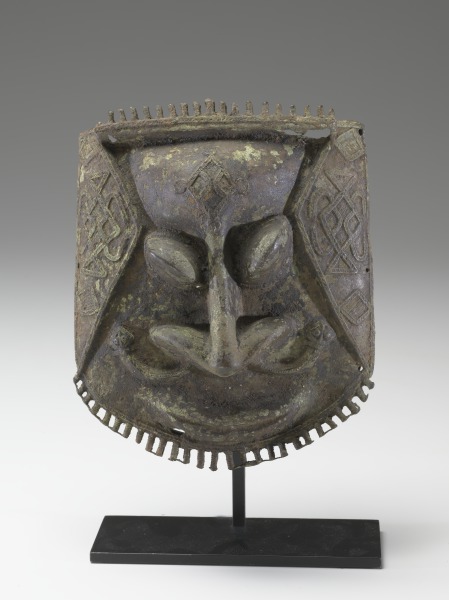
Ogboni Society Plaque, 19th century or earlier, Yoruba culture (Nigeria, Republic of Benin), Copper alloy, 8 5/8 in. high, Adolph D. and Wilkins C. Williams Fund, 2000.97
I am...a Farmer
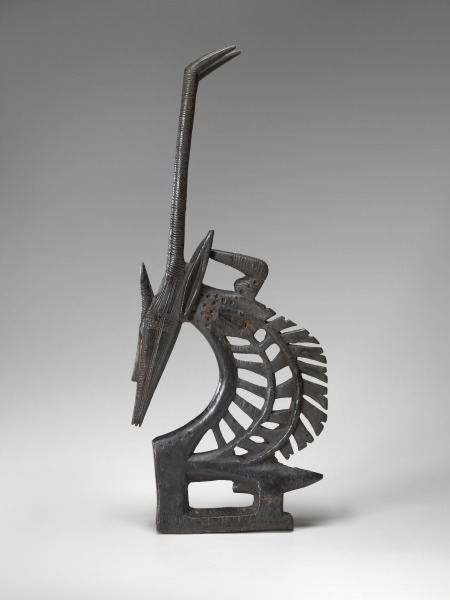
Chi Wara Headdress, 19th–20th century, Bamana culture (Mali), Wood, 34 in. high, Adolph D. and Wilkins C. Williams Fund, 77.93
Another object from the Bamana people of Mali is this Chi Wara Headdress, part of a mask consisting of long strands of raffia (grasslike material) that cover the wearer’s face and body. The headdress borrows features from two different animals: it has the snout of an aardvark, which digs in the ground like a farmer, and the antlers of an antelope. Highly regarded among the Bamana, the antelope bends its neck just as cultivators bend their backs, and its long antlers are as straight and slender as growing millet stalks, a major crop in the area. Chi Wara, a supernatural being who was half-human and half-animal, was the first farmer; he taught mankind how to cultivate the fields and continues to instruct the Bamana people in agricultural affairs.
During annual ceremonies Chi Wara masquerades always involve two masks symbolizing the productive union of men and women. The masked participants bend over as if hoeing the ground.
I am...a Judge
Masquerades are vital in many African cultures, providing entertainment, helping to solve problems, and unifying the community. This full mask ensemble embodied the Dan judgment spirit Ga Wree-Wre, who descends on the community to help settle disputes.
Ga Wree-Wre’s eyes are covered with white pigment as a sign of purity and beauty. The spirit wears an elaborate headdress featuring cowrie shells, glass beads, and a coneshaped hat. Strung along the chin are more beads, brass bells, and brass leopard’s teeth, and a cloak of striped fabric falls over the raffia skirt.
Ga Wree-Wre’s costume combines elements of the wilderness- forest (raffia skirt) and animals (leopard’s teeth)- with the ingenuity and style of human civilization (textiles, metalwork, beads) to signify the spirit’s role in both realms: Dan spirits reside in the forest and enter the village when needed. Unlike other masks, however, Ga Wree-Wre does not dance. Instead, this spirit moves slowly and gracefully, sitting when necessary to review issues carefully before judgment is made. Ga Wree-Wre (as well as other Dan masks) has human interpreters who translate its expressions.
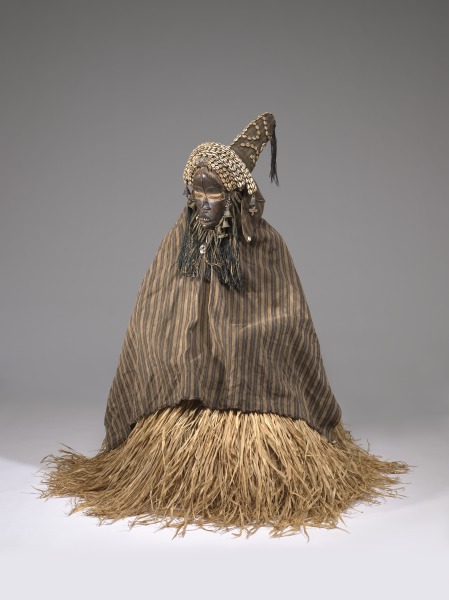
Ga Wree-Wre Mask, 19th–20th century, Dan culture (Liberia), Wood, metal, fiber, cowrie shells, glass beads, brass, bone,, hand-woven cloth (raffia skirt not original), 47 in. high, Adolph D. and Wilkins C. Williams Fund, 92.242
I am...a Young Man
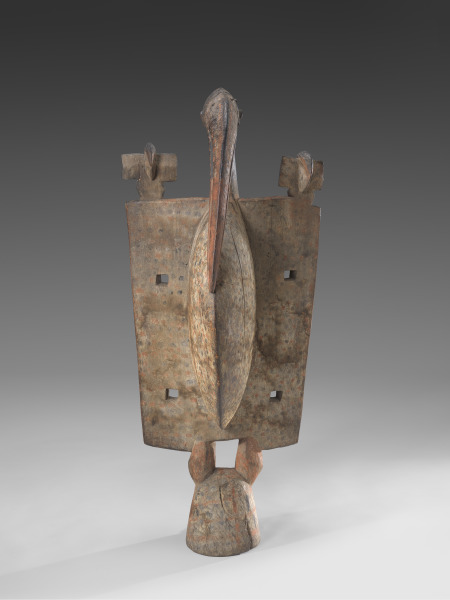
Statue of a Bird, 20th century, Senufo culture (Mali, Northern Côte d’Ivoire, Burkina Faso), Painted wood, 52 ¼ in. high, Gift of Robert and Nancy Nooter, 85.1541
This statue symbolizes Senufo [suh-noo-fo] beliefs regarding ancestry, family, and community. According to Senufo myth, the bird was present with the first man and woman. Sometimes the bird itself is called “the first ancestor.” Perched on its winglike flanks, the two young birds on this statue symbolize the next generation.
The bird represented here is a hornbill. Male and female hornbills work together to create a safe nesting site, usually in the hole of a tree. About a week before laying her eggs, the mother walls up the hole with mud, leaving just enough space to enter. Once she is inside, the father hornbill packs her in, this time leaving just enough space to slip food in to her and the chicks. When the chicks are too big to stay in the nest they break out. This nesting habit is seen as a metaphor for rebirth or regeneration, an important concept for the poro, a male Senufo society whose young initiates proudly wear these statues as headdresses in recognition of their strength and passage into manhood.
I am...a Deity
Esu [eh-shoo], the messenger god, is an omnipresent force in the Yoruba world. If a person pays respect and makes offerings to him, Esu will communicate with the other gods (orisa) on his or her behalf. But if he is not properly honored he becomes a trickster, garbling messages and wreaking havoc. Esu controls a person’s life force, enabling (or disabling) sight, intelligence, and awareness. It is therefore imperative for an individual to maintain a good relationship with him.
When Esu wants to send a message, he sounds a flute, as shown on this staff. A second face, which represents Esu’s dual nature and his presence in the spirit world, appears at the tip of the arc projecting from his head. To carry this staff, a devotee would hook it over his or her shoulder, so that one face looks forward, the other back.
The carvings along the top of the staff ’s arc represent medicine gourds. The cowrie shells carved on the sides— along with the actual shells, beads, and sacks suspended from Esu’s shoulders—are signs of wealth and power and are meant to encourage others to become followers of this important Yoruba deity.
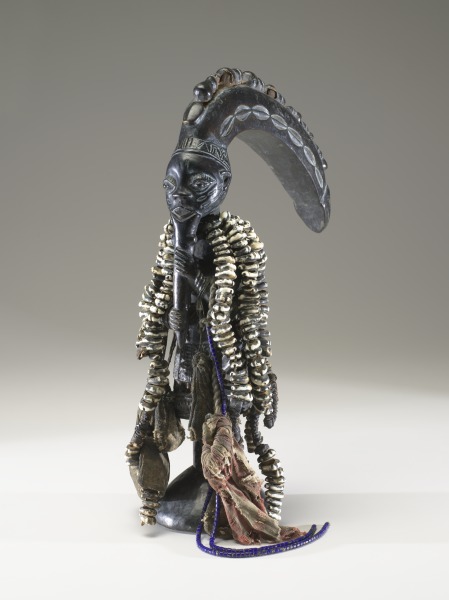
Esu Staff, 19th–20th century, Yoruba culture (Nigeria, Republic of Benin), Wood, cowrie shells, glass beads, string, cloth, seeds, 15 3/8 in. high, Arthur and Margaret Glasgow Fund, 88.43
I am...a Mother
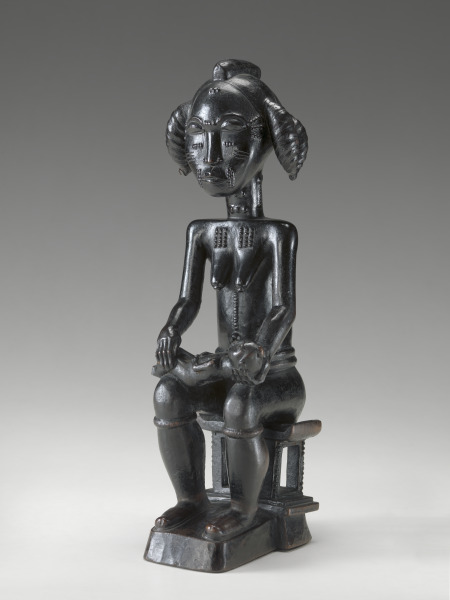
Seated Mother and Child, late 19th–early 20th century, Baule culture (Côte d’Ivoire), Wood, 19 in. high, Arthur and Margaret Glasgow Fund, 2000.3
This beautifully carved work depicts a mother cradling her child. She herself is an embodiment of beauty–from her intricate body marks to her lovely sculpted hairstyle. At the same time, though she holds her child gently, her erect posture and impassive face register the remoteness of nobility.
Women are highly regarded in many African societies as the givers of life, and royal lineage often follows the female line. This woman’s seat—a typical Akan throne designed with upward curving edges and supported on five pillars—signals her royal status.
The Akan people say that a woman must be “strong and solidly rooted on the earth, but upright on it.” Made for an altar or shrine dealing with fertility, this figure exemplifies strength as she celebrates the beginning of new life.
I am...a Healer
A recurring theme in African culture is the separation between civilization and a wilderness seen as full of mystery and danger. Those who are able to harness the supernatural forces outside the boundaries of a community are revered as extraordinary individuals. This large calabash (a kind of gourd), here placed on a wickerwork stand, would have been employed by a healer belonging to the Suaga [soo-aga] association, a group that deals with community justice, protection from evil forces, and ritual cleansing.
The objects attached to the wicker bands encircling the calabash speak to the owner’s mastery over the two realms of spirits—nature spirits and ancestral spirits. Control of natural forces is represented by animal elements and shells, while ancestral spirits are invoked through the five statuettes. Called tadep, the figures characteristically show the left hand or both hands raised to the chin in a gesture linked to the Suaga association.
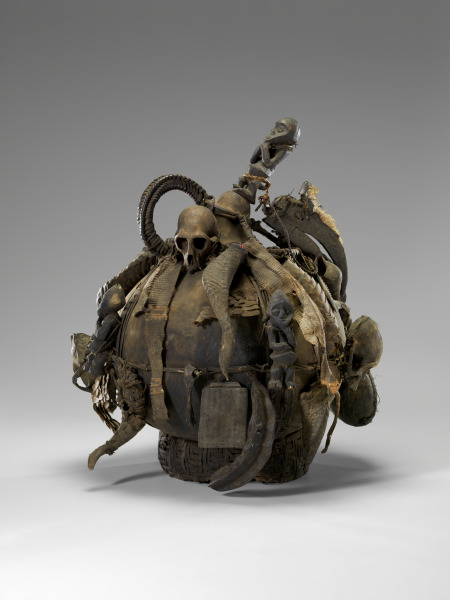
Diviner’s Calabash, 19th–20th century, Mambila culture (Nigeria, Cameroon), Calabash, wood, wicker, shell, horn, bone,, other natural materials, 24 in. high, Kathleen Boone Samuels Memorial Fund, 2010.7a-b
I am...a King
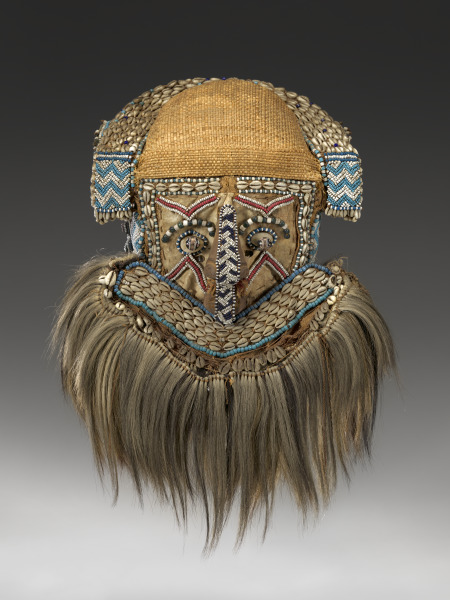
Moshambwooy Mask, 19th–20th century, Kuba culture (Democratic Republic of Congo), Raffia cloth, glass beads, cowries, fur, wood, hide, 17 in. high, Arthur and Margaret Glasgow Fund, 2010.63
The Kuba [koo-ba] make up one of the greatest kingdoms of central Africa. Moshambwooy represents both the king and Woot, the legendary founder of the Kuba. When used to act out familiar Kuba myths and stories, this mask is accompanied by other masks. One story, for example, features a mask that portrays the king’s brother (and the common man), who tries to steal the king’s power and take away his wife, represented by a mask that also signifies the beauty of women. The king, being the more powerful and stronger of the two, wins the struggle and keeps both his wife and his royal power.
The Kuba are highly regarded for their patterning and beading skills, which can be seen in the Moshambwooy mask. Notice the white animal-hair beard, which underscores age and knowledge. It appears that Moshambwooy is bald, but depending on the performance, he will wear different head crests.
I am...a Wife
In 1883 white settlers defeated the Ndebele [in-deb-lay] and confiscated their land, forcing them to relocate to different parts of South Africa. Art became a way to assert their identity, and they use similar bold, colorful, geometric designs for their homes, clothing, and jewelry. Beaded garments, common throughout southern Africa, often signify the wearer’s stage in life and convey aspects of their individual identity. Different types of beaded artifacts may communicate social and marital status, number of children, and a person’s home region or ethnicity.
Ndebele beaded aprons are made and worn by women, who embroider them with glass seed beads in a simple design for everyday use or in more elaborate patterns for ceremonial use. This five-paneled apron, called an ijogolo, is reserved for married women; traditionally the groom’s family gives the bride a plain leather or canvas apron for her to embroider. Each of the five panels represents a calf, which in turn symbolizes future children.
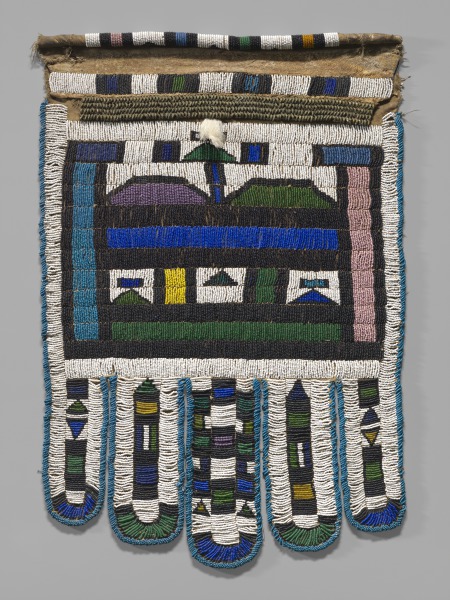
Beaded Apron, 19th–20th century, Ndebele culture (South Africa)
Leather, glass beads, string, 27 5/8 in. high, From the Robert and Nancy Nooter Collection,, Adolph D. and Wilkins C. Williams Fund, 2008.17
I am...an Orator
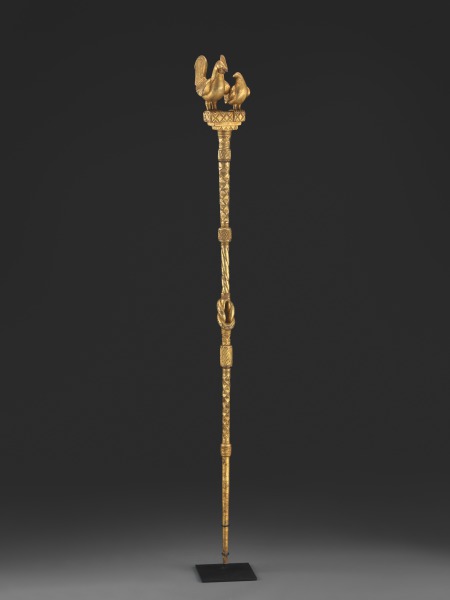
Linguist’s Staff, 20th century, Asante culture (Ghana), Gilded wood
65 ½ in. high, Kathleen Boone Samuels Memorial Fund, 86.200a-c
Traditional African cultures value oral history, and the Akan are especially known for their subtle and elegant spoken language. It is not surprising, therefore, that an orator is an important member of the chief’s entourage and his staff an important part of the spectacle. In addition to being an accomplished linguist, he is well-versed in the folk stories and traditional proverbs of his people and serves as an advisor and spokesman for the chief. In performing these roles, a linguist is sometimes called a “wife” of the chief.
A distinctive aspect of the Akan language is the use of similes and metaphors; connecting the verbal and the visual is a cornerstone of Akan aesthetics. The finial of this staff illustrates the proverb of the rooster and the hen. The rooster looks straight ahead, while the hen turns to whisper something in his ear. The message is that the king does nothing without consent from his “wife.”
Below the finial are two shafts covered with geometric designs and connected by a “wisdom knot.” The entire staff is made of wood and then covered with thin sheets of gold.
I am...an Ancestor
The Yoruba believe that the welfare of the living depends on their relationship with their ancestors, “beings from beyond” who still exist. Yoruba festivals to honor ancestors include dramatic appearances by dancers wearing body-length masks, known as Egungun, with layer upon layer of brightly patterned cloth. The cascade of fabrics conceals the dancer, who peers out through a mesh panel at the top.
During the Egungun’s spinning dance, the strips of fabric fly out dramatically, as if in a whirlwind, evoking the return of ancestral spirits to the community of the living. Sometimes newer, machine-made layers cover older, hand-woven ones that are visible at the mask’s lower edges, revealing that the mask has been used over a period of years.
A carved headdress of a subject relevant to a particular family and its ancestors may be affixed to the top of an Egungun mask, and family members may add strands of cowrie shells to the costume to show their wealth. Like all masks, the Egungun conceals its wearer’s identity because it is meant to reveal instead the presence of an ancestor or spirit that is otherwise unseen.
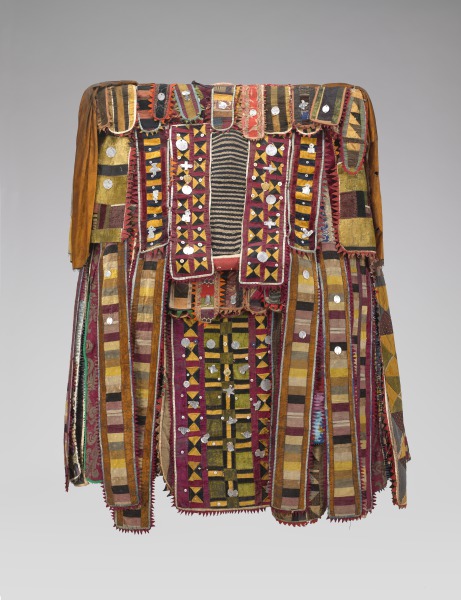
Egungun Mask, 20th century, Yoruba (Nigeria, Republic of Benin), Cloth, metal, mixed media, 63 in. high, Gift of Dr. and Mrs. Jeffrey Hammer, 92.133
